child seat CADILLAC ESCALADE 2010 3.G Owners Manual
[x] Cancel search | Manufacturer: CADILLAC, Model Year: 2010, Model line: ESCALADE, Model: CADILLAC ESCALADE 2010 3.GPages: 616, PDF Size: 39.41 MB
Page 1 of 616

2010 Cadillac Escalade/Escalade ESV Owner ManualM
In Brief. . . . . . . . . . . . . . . . . . . . . . . . . . . . . . . . . . . . . . . . . . . . 1-1Instrument Panel . . . . . . . . . . . . . . . . . . . . . . . . . . . . . . . . . 1-2Initial Drive Information . . . . . . . . . . . . . . . . . . . . . . . . . . . 1-4Vehicle Features . . . . . . . . . . . . . . . . . . . . . . . . . . . . . . . . 1-16Performance and Maintenance . . . . . . . . . . . . . . . . . . 1-22
Seats and Restraint System. . . . . . . . . . . . . . . . . . . . . . 2-1Head Restraints . . . . . . . . . . . . . . . . . . . . . . . . . . . . . . . . . . 2-2Front Seats . . . . . . . . . . . . . . . . . . . . . . . . . . . . . . . . . . . . . . . 2-4Rear Seats . . . . . . . . . . . . . . . . . . . . . . . . . . . . . . . . . . . . . . 2-10Safety Belts . . . . . . . . . . . . . . . . . . . . . . . . . . . . . . . . . . . . . 2-26Child Restraints . . . . . . . . . . . . . . . . . . . . . . . . . . . . . . . . . 2-49Airbag System . . . . . . . . . . . . . . . . . . . . . . . . . . . . . . . . . . 2-74Restraint System Check . . . . . . . . . . . . . . . . . . . . . . . . . 2-91
Features and Controls. . . . . . . . . . . . . . . . . . . . . . . . . . . . 3-1Keys . . . . . . . . . . . . . . . . . . . . . . . . . . . . . . . . . . . . . . . . . . . . . 3-3Doors and Locks . . . . . . . . . . . . . . . . . . . . . . . . . . . . . . . . 3-10Windows . . . . . . . . . . . . . . . . . . . . . . . . . . . . . . . . . . . . . . . . 3-18Theft-Deterrent Systems . . . . . . . . . . . . . . . . . . . . . . . . 3-22Starting and Operating Your Vehicle . . . . . . . . . . . . . 3-26Mirrors . . . . . . . . . . . . . . . . . . . . . . . . . . . . . . . . . . . . . . . . . . 3-43Object Detection Systems . . . . . . . . . . . . . . . . . . . . . . . 3-46Universal Home Remote System . . . . . . . . . . . . . . . . 3-55Storage Areas . . . . . . . . . . . . . . . . . . . . . . . . . . . . . . . . . . . 3-62Sunroof . . . . . . . . . . . . . . . . . . . . . . . . . . . . . . . . . . . . . . . . . 3-66
Instrument Panel. . . . . . . . . . . . . . . . . . . . . . . . . . . . . . . . . 4-1Instrument Panel Overview . . . . . . . . . . . . . . . . . . . . . . . 4-3Climate Controls . . . . . . . . . . . . . . . . . . . . . . . . . . . . . . . . 4-20Warning Lights, Gages, and Indicators . . . . . . . . . . 4-27Driver Information Center (DIC) . . . . . . . . . . . . . . . . . 4-41Audio System(s) . . . . . . . . . . . . . . . . . . . . . . . . . . . . . . . . 4-67
Page 17 of 616

Safety Belt
Refer to the following sections for important informationon how to use safety belts properly.
.Safety Belts: They Are for Everyone on page 2!26.
.How to Wear Safety Belts Properly on page 2!30.
.Lap-Shoulder Belt on page 2!39.
.Lower Anchors and Tethers for Children (LATCH)on page 2!59.
Sensing System for Passenger
Airbag
The passenger sensing system, if equipped, will turn offthe right front passenger frontal airbag under certainconditions. The driver airbags, seat!mounted sideimpact airbags, if equipped, and roof!rail airbags arenot affected by this.
If the vehicle has one of the indicators pictured in thefollowing illustrations, then the vehicle has a passengersensing system for the right front passenger position.
The passenger airbag status indicator, if equipped, willbe visible on the overhead console when the vehicleis started.
United StatesCanada
SeePassenger Sensing Systemon page 2!84forimportant information.
1-11
Page 33 of 616
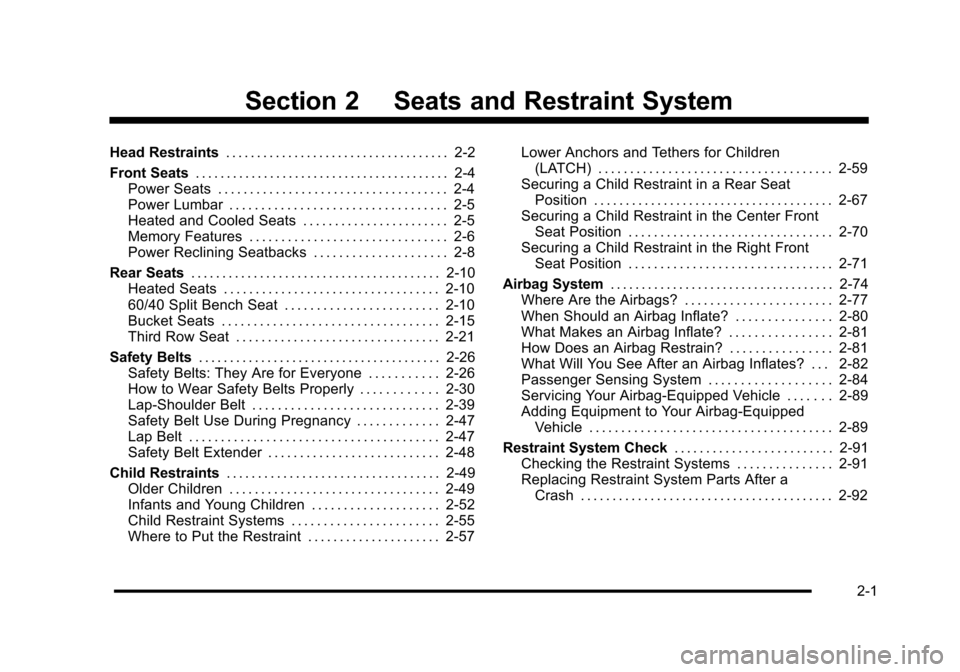
Section 2 Seats and Restraint System
Head Restraints. . . . . . . . . . . . . . . . . . . . . . . . . . . . . . . . . . . . 2-2
Front Seats. . . . . . . . . . . . . . . . . . . . . . . . . . . . . . . . . . . . . . . . . 2-4Power Seats . . . . . . . . . . . . . . . . . . . . . . . . . . . . . . . . . . . . 2-4Power Lumbar . . . . . . . . . . . . . . . . . . . . . . . . . . . . . . . . . . 2-5Heated and Cooled Seats . . . . . . . . . . . . . . . . . . . . . . . 2-5Memory Features . . . . . . . . . . . . . . . . . . . . . . . . . . . . . . . 2-6Power Reclining Seatbacks . . . . . . . . . . . . . . . . . . . . . 2-8
Rear Seats. . . . . . . . . . . . . . . . . . . . . . . . . . . . . . . . . . . . . . . . 2-10Heated Seats . . . . . . . . . . . . . . . . . . . . . . . . . . . . . . . . . . 2-1060/40 Split Bench Seat . . . . . . . . . . . . . . . . . . . . . . . . 2-10Bucket Seats . . . . . . . . . . . . . . . . . . . . . . . . . . . . . . . . . . 2-15Third Row Seat . . . . . . . . . . . . . . . . . . . . . . . . . . . . . . . . 2-21
Safety Belts. . . . . . . . . . . . . . . . . . . . . . . . . . . . . . . . . . . . . . . 2-26Safety Belts: They Are for Everyone . . . . . . . . . . . 2-26How to Wear Safety Belts Properly . . . . . . . . . . . . 2-30Lap-Shoulder Belt . . . . . . . . . . . . . . . . . . . . . . . . . . . . . 2-39Safety Belt Use During Pregnancy . . . . . . . . . . . . . 2-47Lap Belt . . . . . . . . . . . . . . . . . . . . . . . . . . . . . . . . . . . . . . . 2-47Safety Belt Extender . . . . . . . . . . . . . . . . . . . . . . . . . . . 2-48
Child Restraints. . . . . . . . . . . . . . . . . . . . . . . . . . . . . . . . . . 2-49Older Children . . . . . . . . . . . . . . . . . . . . . . . . . . . . . . . . . 2-49Infants and Young Children . . . . . . . . . . . . . . . . . . . . 2-52Child Restraint Systems . . . . . . . . . . . . . . . . . . . . . . . 2-55Where to Put the Restraint . . . . . . . . . . . . . . . . . . . . . 2-57
Lower Anchors and Tethers for Children(LATCH) . . . . . . . . . . . . . . . . . . . . . . . . . . . . . . . . . . . . . 2-59Securing a Child Restraint in a Rear SeatPosition . . . . . . . . . . . . . . . . . . . . . . . . . . . . . . . . . . . . . . 2-67Securing a Child Restraint in the Center FrontSeat Position . . . . . . . . . . . . . . . . . . . . . . . . . . . . . . . . 2-70Securing a Child Restraint in the Right FrontSeat Position . . . . . . . . . . . . . . . . . . . . . . . . . . . . . . . . 2-71
Airbag System. . . . . . . . . . . . . . . . . . . . . . . . . . . . . . . . . . . . 2-74Where Are the Airbags? . . . . . . . . . . . . . . . . . . . . . . . 2-77When Should an Airbag Inflate? . . . . . . . . . . . . . . . 2-80What Makes an Airbag Inflate? . . . . . . . . . . . . . . . . 2-81How Does an Airbag Restrain? . . . . . . . . . . . . . . . . 2-81What Will You See After an Airbag Inflates? . . . 2-82Passenger Sensing System . . . . . . . . . . . . . . . . . . . 2-84Servicing Your Airbag-Equipped Vehicle . . . . . . . 2-89Adding Equipment to Your Airbag-EquippedVehicle . . . . . . . . . . . . . . . . . . . . . . . . . . . . . . . . . . . . . . 2-89
Restraint System Check. . . . . . . . . . . . . . . . . . . . . . . . . 2-91Checking the Restraint Systems . . . . . . . . . . . . . . . 2-91Replacing Restraint System Parts After aCrash . . . . . . . . . . . . . . . . . . . . . . . . . . . . . . . . . . . . . . . . 2-92
2-1
Page 72 of 616
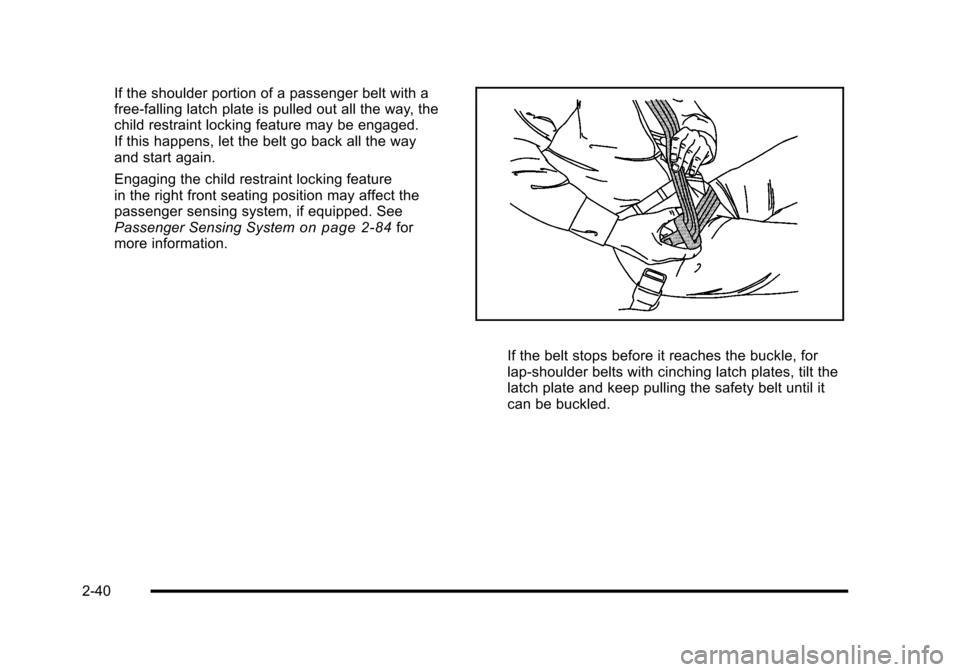
If the shoulder portion of a passenger belt with afree!falling latch plate is pulled out all the way, thechild restraint locking feature may be engaged.If this happens, let the belt go back all the wayand start again.
Engaging the child restraint locking featurein the right front seating position may affect thepassenger sensing system, if equipped. SeePassenger Sensing Systemon page 2!84formore information.
If the belt stops before it reaches the buckle, forlap!shoulder belts with cinching latch plates, tilt thelatch plate and keep pulling the safety belt until itcan be buckled.
2-40
Page 75 of 616
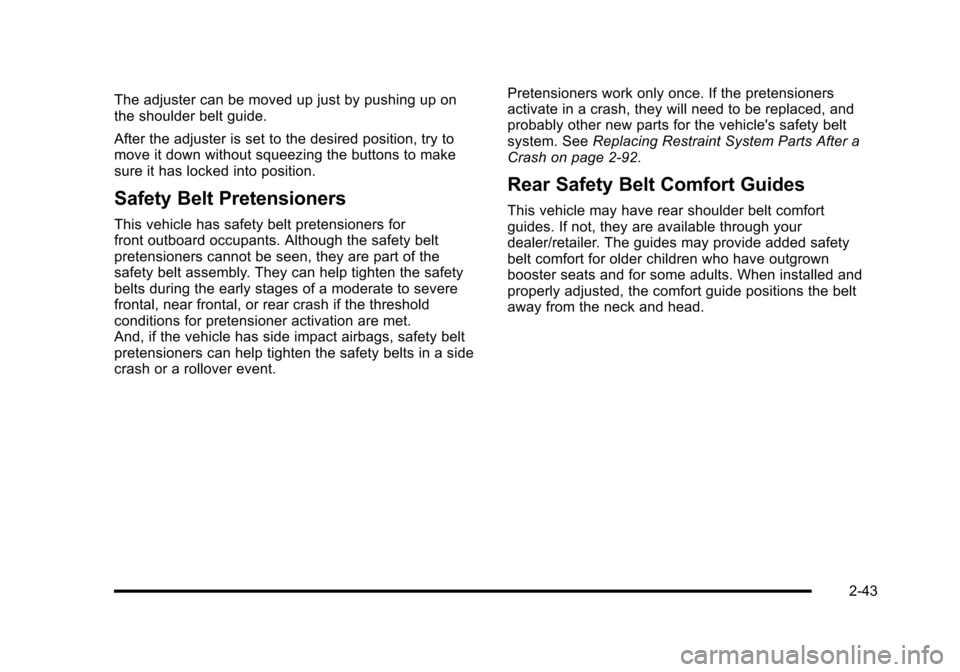
The adjuster can be moved up just by pushing up onthe shoulder belt guide.
After the adjuster is set to the desired position, try tomove it down without squeezing the buttons to makesure it has locked into position.
Safety Belt Pretensioners
This vehicle has safety belt pretensioners forfront outboard occupants. Although the safety beltpretensioners cannot be seen, they are part of thesafety belt assembly. They can help tighten the safetybelts during the early stages of a moderate to severefrontal, near frontal, or rear crash if the thresholdconditions for pretensioner activation are met.And, if the vehicle has side impact airbags, safety beltpretensioners can help tighten the safety belts in a sidecrash or a rollover event.
Pretensioners work only once. If the pretensionersactivate in a crash, they will need to be replaced, andprobably other new parts for the vehicle's safety beltsystem. SeeReplacing Restraint System Parts After aCrash on page 2!92.
Rear Safety Belt Comfort Guides
This vehicle may have rear shoulder belt comfortguides. If not, they are available through yourdealer/retailer. The guides may provide added safetybelt comfort for older children who have outgrownbooster seats and for some adults. When installed andproperly adjusted, the comfort guide positions the beltaway from the neck and head.
2-43
Page 80 of 616
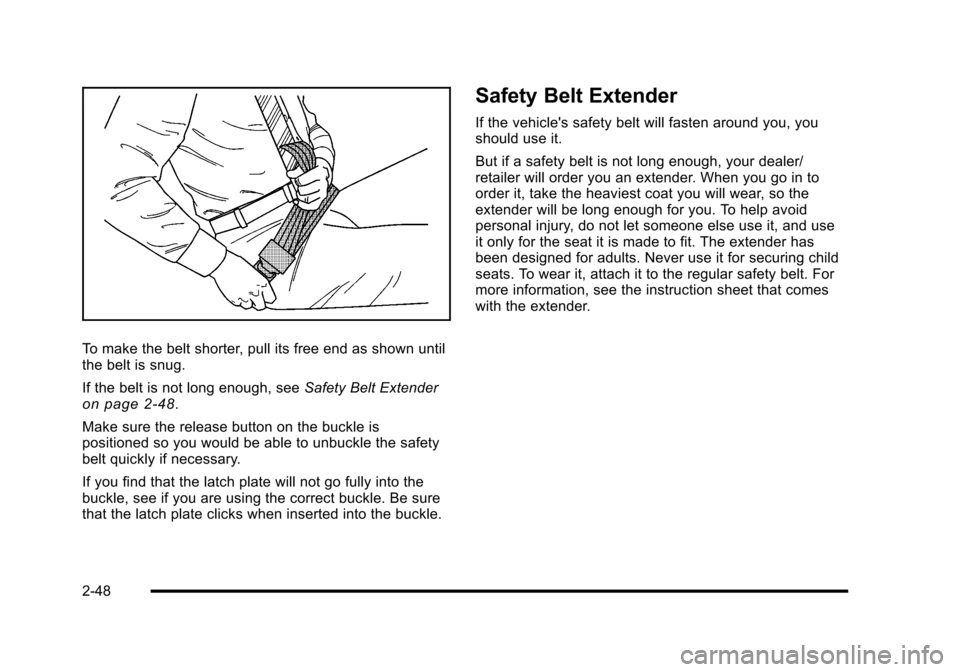
To make the belt shorter, pull its free end as shown untilthe belt is snug.
If the belt is not long enough, seeSafety Belt Extenderon page 2!48.
Make sure the release button on the buckle ispositioned so you would be able to unbuckle the safetybelt quickly if necessary.
If you find that the latch plate will not go fully into thebuckle, see if you are using the correct buckle. Be surethat the latch plate clicks when inserted into the buckle.
Safety Belt Extender
If the vehicle's safety belt will fasten around you, youshould use it.
But if a safety belt is not long enough, your dealer/retailer will order you an extender. When you go in toorder it, take the heaviest coat you will wear, so theextender will be long enough for you. To help avoidpersonal injury, do not let someone else use it, and useit only for the seat it is made to fit. The extender hasbeen designed for adults. Never use it for securing childseats. To wear it, attach it to the regular safety belt. Formore information, see the instruction sheet that comeswith the extender.
2-48
Page 81 of 616
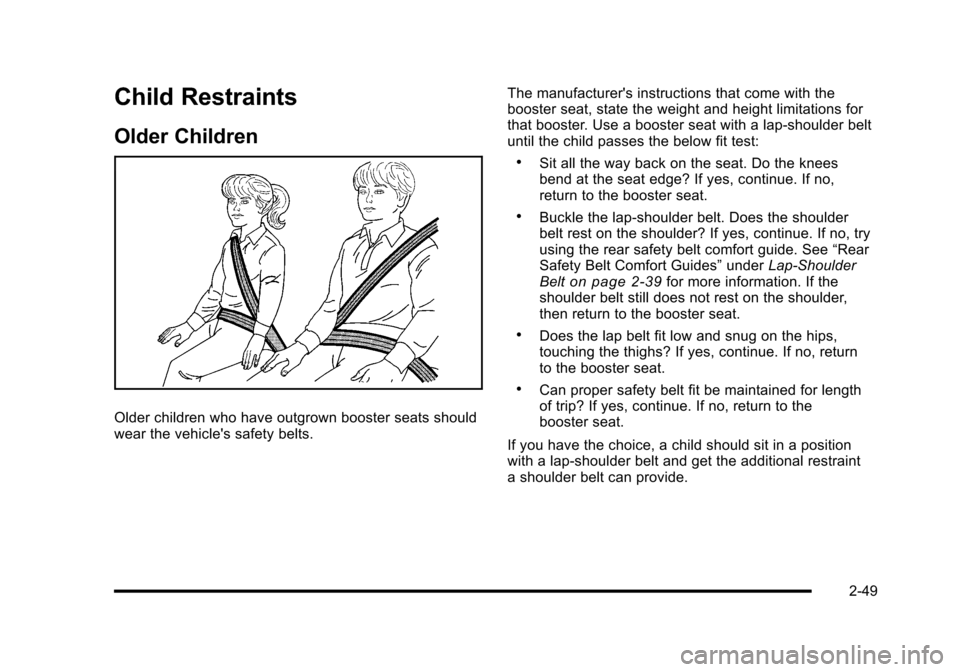
Child Restraints
Older Children
Older children who have outgrown booster seats shouldwear the vehicle's safety belts.
The manufacturer's instructions that come with thebooster seat, state the weight and height limitations forthat booster. Use a booster seat with a lap-shoulder beltuntil the child passes the below fit test:
.Sit all the way back on the seat. Do the kneesbend at the seat edge? If yes, continue. If no,return to the booster seat.
.Buckle the lap-shoulder belt. Does the shoulderbelt rest on the shoulder? If yes, continue. If no, tryusing the rear safety belt comfort guide. See“RearSafety Belt Comfort Guides”underLap-ShoulderBelton page 2!39for more information. If theshoulder belt still does not rest on the shoulder,then return to the booster seat.
.Does the lap belt fit low and snug on the hips,touching the thighs? If yes, continue. If no, returnto the booster seat.
.Can proper safety belt fit be maintained for lengthof trip? If yes, continue. If no, return to thebooster seat.
If you have the choice, a child should sit in a positionwith a lap-shoulder belt and get the additional restrainta shoulder belt can provide.
2-49
Page 82 of 616
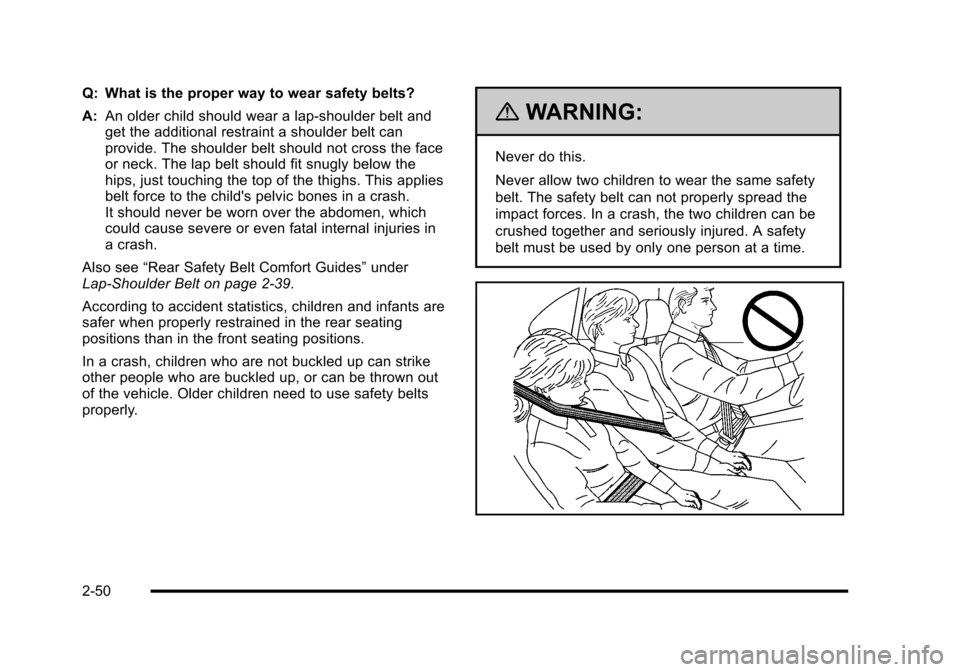
Q: What is the proper way to wear safety belts?
A:An older child should wear a lap-shoulder belt andget the additional restraint a shoulder belt canprovide. The shoulder belt should not cross the faceor neck. The lap belt should fit snugly below thehips, just touching the top of the thighs. This appliesbelt force to the child's pelvic bones in a crash.It should never be worn over the abdomen, whichcould cause severe or even fatal internal injuries ina crash.
Also see“Rear Safety Belt Comfort Guides”underLap-Shoulder Belt on page 2!39.
According to accident statistics, children and infants aresafer when properly restrained in the rear seatingpositions than in the front seating positions.
In a crash, children who are not buckled up can strikeother people who are buckled up, or can be thrown outof the vehicle. Older children need to use safety beltsproperly.
{WARNING:
Never do this.
Never allow two children to wear the same safety
belt. The safety belt can not properly spread the
impact forces. In a crash, the two children can be
crushed together and seriously injured. A safety
belt must be used by only one person at a time.
2-50
Page 85 of 616
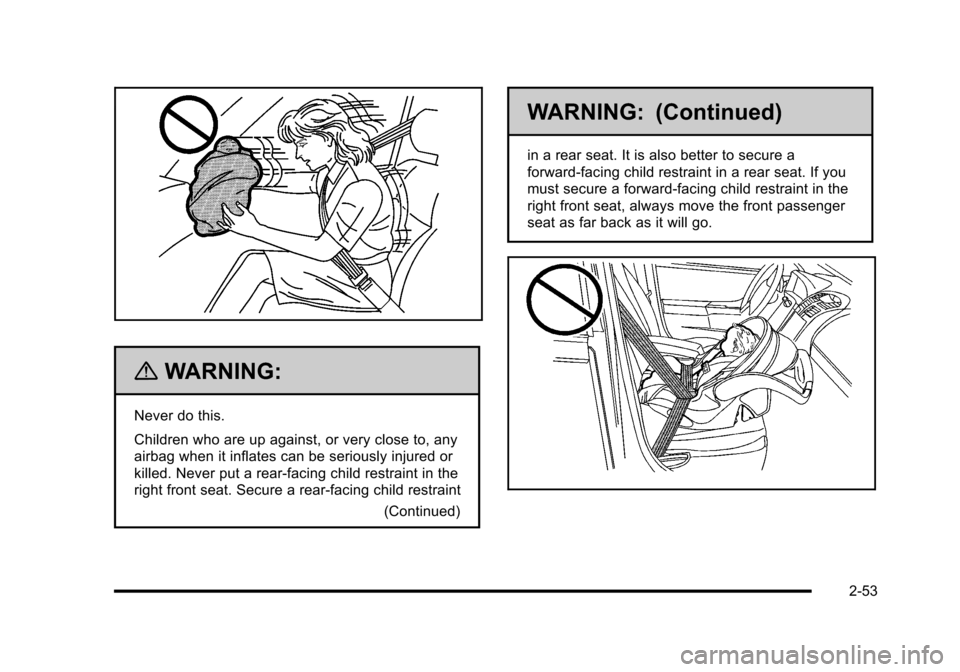
{WARNING:
Never do this.
Children who are up against, or very close to, any
airbag when it inflates can be seriously injured or
killed. Never put a rear-facing child restraint in the
right front seat. Secure a rear-facing child restraint
(Continued)
WARNING: (Continued)
in a rear seat. It is also better to secure a
forward-facing child restraint in a rear seat. If you
must secure a forward-facing child restraint in the
right front seat, always move the front passenger
seat as far back as it will go.
2-53
Page 87 of 616
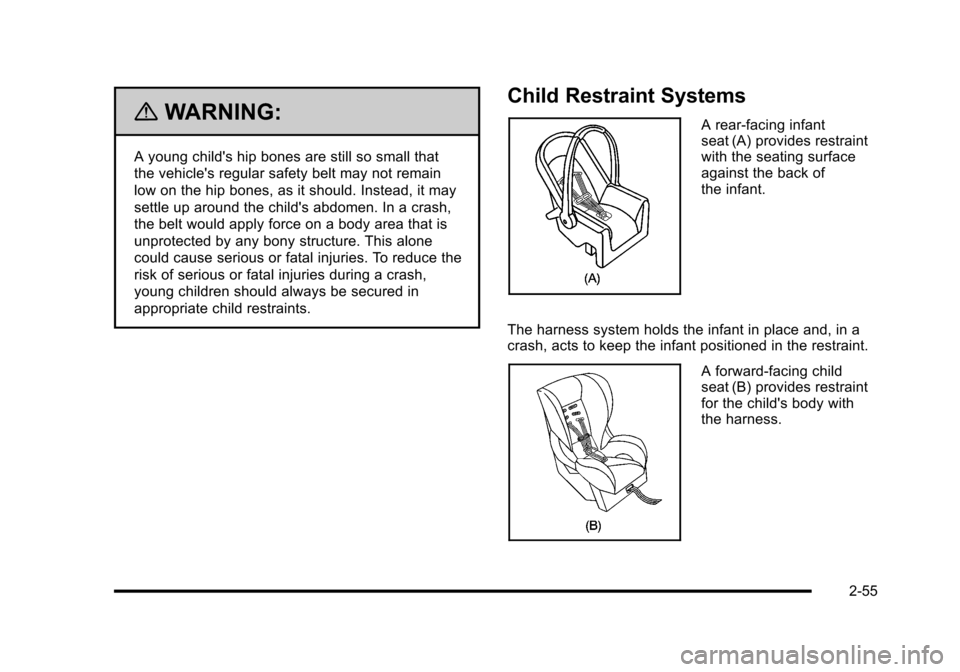
{WARNING:
A young child's hip bones are still so small that
the vehicle's regular safety belt may not remain
low on the hip bones, as it should. Instead, it may
settle up around the child's abdomen. In a crash,
the belt would apply force on a body area that is
unprotected by any bony structure. This alone
could cause serious or fatal injuries. To reduce the
risk of serious or fatal injuries during a crash,
young children should always be secured in
appropriate child restraints.
Child Restraint Systems
A rear-facing infantseat (A) provides restraintwith the seating surfaceagainst the back ofthe infant.
The harness system holds the infant in place and, in acrash, acts to keep the infant positioned in the restraint.
A forward-facing childseat (B) provides restraintfor the child's body withthe harness.
2-55